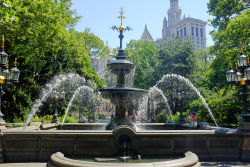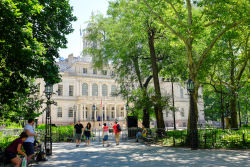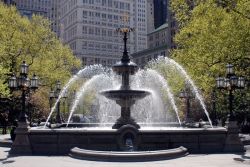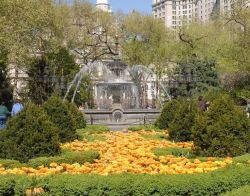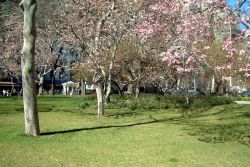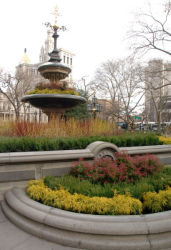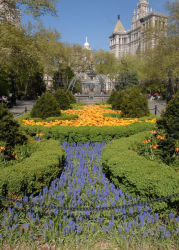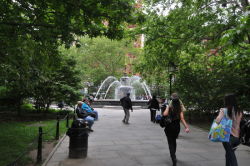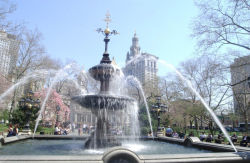City Hall Park
Mayor Bloomberg And The Public Art Fund Announce “Alexander Calder In New York”
Friday, April 21, 2006
No. 124
http://www.nyc.gov/parks
Mayor Michael R. Bloomberg and the Public Art Fund today announced their next public art collaboration in Lower Manhattan, a major exhibition of works by Alexander Calder, one of the most popular and influential artists of our time. With five of his large metal stabiles in City Hall Park, "Alexander Calder in New York" is the first multi-work presentation of the artist’s iconic sculptures in New York’s outdoor spaces. The exhibition also features one of Calder’s signature hanging mobiles, which will be shown in the dramatic rotunda of City Hall. "Alexander Calder in New York" is the fourth exhibition sponsored by Forest City Ratner Companies that the Public Art Fund has organized in City Hall Park since 2003.
"We are honored to host this exhibition of modern master Alexander Calder’s sculptures and welcome the Public Art Fund’s fourth show to City Hall Park," said Mayor Bloomberg. "We have had a tremendous response to the first three shows and expect that our latest collaboration will complement our City’s thriving public art program, which exists throughout the City. Whether you are looking at Calder’s ‘Untitled’ in the historic rotunda of City Hall or ‘Jerusalem Stabile’ set against the majestic backdrop of the Brooklyn Bridge, it is our hope that this exhibition will inspire New Yorkers and visitors alike."
"We are thrilled to be able to return to City Hall Park with this exhibition of works by Alexander Calder," said Susan K. Freedman, President of the Public Art Fund. "It is an honor and a pleasure to collaborate with the Mayor to present examples of the greatest art of our time to the public in this beautiful location in New York City."
Alexander Calder is one of the 20th century’s most inventive and influential artists, and his mobiles (hanging sculptures) and monumental stabiles (freestanding sculptures) are among the most beloved and iconic works of American art. Throughout his illustrious career, Alexander Calder (1898-1976) explored issues of color, form, anthropomorphism, abstraction and scale, all of which can be seen at play in the selection of works in this exhibition. Calder was an engineer by training, and his large stabiles epitomize his technical mastery of industrial materials; but they also demonstrate his joyful imagination and sense of harmony and balance. Made between 1957 and 1976, a period when he had devoted himself to making outdoor sculpture on a grand scale from bolted sheet steel, the works in "Alexander Calder in New York" include Seven-Legged Beast (1957), The Arches (1959), The Cock’s Comb (1960), La chien en trois couleurs (Three-Colored Dog) (1973), Jerusalem Stabile (1:3 intermediate maquette) (1976) and the mobile Untitled (1976).
"Stabile" is the term – coined by artist Jean Arp – that Calder used throughout his life to describe his freestanding, nonmoving sculptures.
Between 1957 and 1959, Calder began to work on an increasingly monumental scale. He perfected the sculptural technique of welding and bolting that he continued to use throughout his career; Seven-Legged Beast (1957) is one the first pieces he made in this manner. The Arches (1959) and The Cock’s Comb (1960), two black sheet metal constructions, further illustrate his ongoing exploration of abstract forms in space. The dynamic black, red, and blue stabile La chien en trois couleurs (1973) exemplifies his interest in color.
The centerpiece of the exhibition is a vibrant red sculpture, Jerusalem Stabile (1:3 intermediate maquette) (1976), a one-third scale version of one of Calder’s last major commissions, a permanent work in Jerusalem, Israel. Spanning 24 feet, this steel maquette is monumental in its own right. From its position on the sidewalk on the eastern side of City Hall Park, Jerusalem Stabile will be visible from the Brooklyn Bridge. In delicate counterpoint to this monumental work, Untitled (1976), one of the last hanging mobiles the artist made before his death, will be installed in the rotunda of City Hall.
"The monumental sculptures of Alexander Calder are important modernist works from the mid-20th century, but their bright colors and lively shapes still delight audiences today," said Parks Commissioner Adrian Benepe. "We are proud to feature this exhibition as part of the public art programs in City parks."
"This spectacular exhibit affords New Yorkers and visitors the opportunity to enjoy the work of one of America’s most renowned sculptors as they stroll through City Hall Park," said Cultural Affairs Commissioner Kate Levin. "It also underscores this Administration’s enthusiasm for and commitment to public art – whether through monumental temporary projects like The Gates in Central Park or through the hundreds of permanent artworks at sites in all five boroughs commissioned by the Percent for Art program. Thanks to Mayor Bloomberg’s leadership, New York City is today more beautiful, inviting, and inspiring than ever before."
In addition to the works on view in this temporary exhibition, there are a number of stabiles and mobiles by Alexander Calder that are on permanent or long-term public display in New York City. Nearest to the City Hall exhibition is Object in Five Planes (1965) at 26 Federal Plaza near Worth and Lafayette Streets. Calder’s monumental mobile .125, commissioned in 1957 for Idlewild Airport (now named John F. Kennedy International Airport), remains on view in International Terminal 4, and another mobile, Untitled (1959), hangs in the Chase bank branch at 410 Park Avenue between 54th and 55th Streets (open Monday – Friday 8 AM - 6 PM). Saurien (1975) is in front of the 590 Madison Building at 57th Street, and Le Guichet (The Ticket Window) (1963) is at Lincoln Center outside of Avery Fisher Hall. His Cirque Calder (1926-30) is on view at the Whitney Museum of American Art. And WTC Stabile (Bent Propeller), a 1971 commission for the World Trade Center, was destroyed in the attacks of September 11, 2001.
Born in Philadelphia in 1898, Alexander Calder was the second child of artist parents. His father, sculptor Alexander Stirling Calder, received a number of public commissions and so, throughout Calder’s childhood, the family traveled often. Calder studied to become an engineer, but in his early twenties decided to pursue a career as an artist. He began by developing a new method of sculpting: by bending and twisting wire, he essentially "drew" three-dimensional figures in space. He lived in Paris from 1926 to 1933, where he created his famous Cirque Calder and had his first solo gallery shows. In 1933, Calder and his wife, Louisa, moved to Roxbury, Connecticut,
where he continued to live and work for the rest of his life. His shift toward abstraction, inspired by a visit to Piet Mondrian’s studio in 1930, resulted in his invention of mobiles and stabiles, two bodies of work that he continued to develop in scale. Calder’s many permanent public sculptures – in Chicago, Paris, Mexico City, Montreal, Jerusalem, and other cities all over the world – are some of the most beloved and important works of the 20th century.
"Alexander Calder in New York" is free and open to the public. Reservations are required for tours of City Hall; to make a reservation or for more information about the exhibition, call 311 or log onto www.nyc.gov. City Hall and City Hall Park are located in Lower Manhattan, and bordered by Broadway, Chambers Street, Centre Street, and Park Row. The nearest subway stations are A, C, E to Chambers Street; 4, 5,6, J, M, Z to Brooklyn Bridge-City Hall; N, R to City Hall; 2, 3 to Park Place.
"Alexander Calder in New York" is the fourth temporary exhibition that the Public Art Fund has organized in City Hall Park since 2003. "Julian Opie: Animals, Buildings, Cars and People" opened in October 2004; "Roy Lichtenstein at City Hall" opened in November 2003; and "MetroSpective," a group exhibition with works by Art Domantay, Brian Tolle, Walter Martin & Paloma Muñoz, Peter Rostovsky, Do-Ho Suh, and Ken Landauer, opened in January 2003. The works in the current exhibition are lent courtesy the Calder Foundation, New York, and by the Whitney Museum of American Art, New York.
-30-
Check out your park's Vital Signs
Clean & Safe
Green & Resilient
Empowered & Engaged Users
Share your feedback or learn more about how this park is part of a
Vital Park System

